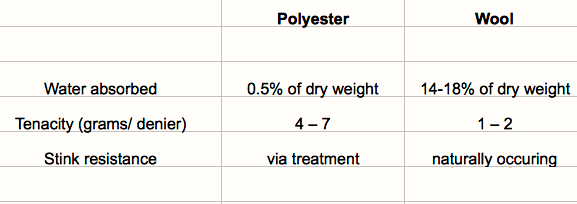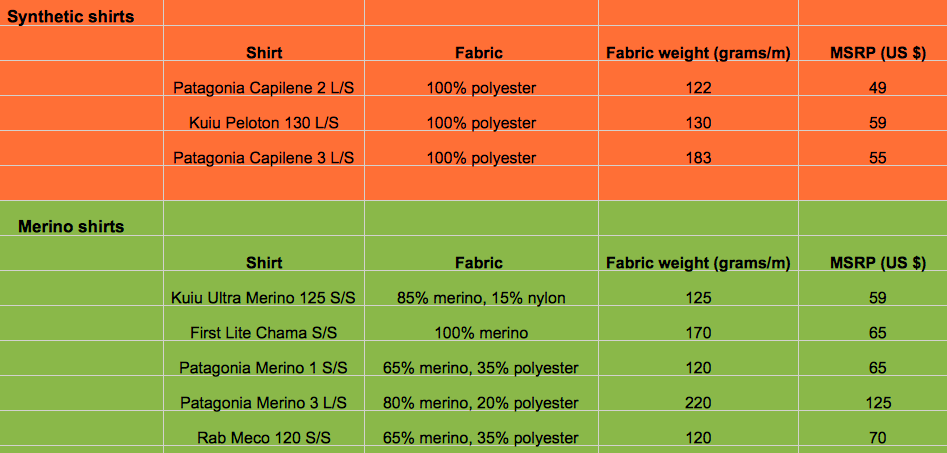Merino/synthetic Blended Baselayers for the Modern Hunter
By Dave Chenault, Rokslide Member
The advantages of merino baselayers are well known. Modern merino is pleasing against the skin, resists odor accumulation to a startling degree, and controls the evaporation of perspiration, thereby enhancing warmth. Unfortunately the shortcomings of merino are equally well known; namely that the heavier weights retain lots of moisture, and that the lighter weights have poor durability. Recent efforts from a variety of companies combine merino with various synthetic fibers in an attempt to retain the benefits of merino, while addressing the deficits. How do baselayers from Rab, Patagonia, and Kuiu pull off this balancing act? I attempted to find out.
Lead Photo: Wearing the Rab Meco 120 t-shirt while packing out a tahr in New Zealand’s Southern Alps. The fast drying Meco fabric is great for hot and cold weather alike
Backcountry hunters need a lot from their against-the-skin layers. These shirts need to protect against sun, abrasion from brush, rocks and backpack straps. These layers also need to move sweat away from the skin to prevent chafing and promote warmth, and to serve the need of a light pack, they must do all these things day after day without washing. Historically a certain degree of compromise has always been necessary here.
Polyester knits have long been the base layer fabric of reference, and for good reason. Poly is a inherently hydrophobic (water-averse) material. The actual fabric of a polyester base layer absorbs a minimal amount of water when saturated, typically around half a percent of its dry weight. By comparison, nylon absorbs around 4%, most cottons absorb between 7 and 9% of their dry weight, and wool between 14 and 18%. This is why polyester baselayers dry so quickly; with minimal water within the fibers of the fabric, body heat need only drive moisture from within the voids of the knit to dry the garment In addition, polyester fibers are much stronger than wool fibers of the same weight (e.g. their tenacity is higher), meaning that all things being equal a polyester shirt will be much more resistant to abrasion and ripping.

The downsides of polyester are a synthetic, plasticy feel and a tendency to cultivate bacteria growth and thus stink after multiple days of use. The voids within the polyester fibers are not especially good at resisting bacteria growth, something outdoor clothing companies have spent decades addressing with various treatments. Most of these worked–some of the more recent ones quite well–but in my experience all of them eventually give in to the funk, and experience a loss in effectiveness over time. Light poly baselayers move moisture well and are tough, but in the end the stench and a rather nasty feel against the skin are, by the standards of current technology, inevitable.
When merino wool came on the baselayer scene around 15 years ago, it provided a compelling alternative to polyester. Merino fibers are water-loving (hydrophilic), and as mentioned above readily absorb an impressive percentage of their dry weight in water, considerably more than even cotton. Unlike cotton, merino is a suitable wilderness baselayer because it is able to release that moisture back into the environment via evaporation in an impressively controlled manner. Polyester and cotton will move moisture via evaporation and heat via convection as fast as environmental conditions will allow, while merino slows both processes down by holding moisture (and thus, heat) within the fibers of the fabric. This is why merino is said to be “warm when wet,” a phrase which is in this case is imprecise but does describe a very real phenomenon which is of great use to backcountry hunters.

The primary shortcoming of merino wool is the poor durability of the fibers. Early attempts at making light weight (less than 150 grams per square meter) pure merino shirts where short lived, as holes and tears rapidly developed at wear points. Thicker merino shirts have proven themselves, with 200 grams/meter seeming to be the threshold at or above which multiple years of solid use can be expected. The problem I have with these heavier weight merino garments is that they are too much of a good thing. 200 grams/meter is the same weight as expedition weight polyester baselayers, and of 100 weight polartec fleece. The lighter poly baselayers best suited to warmer temperatures, and which have the fastest dry times, are around 120 grams/meter. 200 weight merino holds too much moisture, enough that the body heat required to evaporate it is often more than I can afford to give. In harsh, wet conditions these thicker merino layers often made me colder.
Wading the Spotted Bear River in the Bob Marshall Wilderness, wearing an old Patagonia Wool 2 t-shirt. These sub 120 gram/meter shirts worked great, except for the holes, and were thus only on the market for a few years
For a number of years I gave up on merino baselayers. The truly light ones weren’t on the market anymore, and their expense and limited lifespan made them a poor proposition anyway. Thankfully, a few years ago companies began experimenting with various synthetic and merino blends, trying to make light-enough garments which approached the durability of pure poly, while retaining the performance characteristics of wool.
After some trial and error, several companies have settled on a 65% merino, 35% polyester blend. Rab’s Meco 120 and Patagonia’s Merino 1 are outwardly identical fabrics (both are 120 grams/meter) with identical performance in the field. Either shirt is an excellent alternative to pure poly or pure merino baselayers. Both have the very thin feel common to light baselayers. Both dry about 80% as fast as pure poly garments. Both have stood up to almost a year of field use with no holes or tears. Both resist stink much better than any pure poly layer I’ve ever tried, though not as well as pure merino. Overall they’re an excellent compromise between the two fabrics, melding the best attributes of both merino and polyester without too many downsides, and acceptable durability. The Meco in particular, which has a slightly slimmer and longer torso, has become my go-to shirt for any backcountry trip where daytime temps will be above 20 degrees.
The Kuiu Ultra at left, and the Rab Meco at right. Note the subtle differences in the fabrics, the layer of ventilated fabric which runs under the arms and along the sides of the Kuiu shirt, and the contrasting stitching which makes the Rab less than stealthy
With their recent Ultra Merino line, Kuiu has taken a different approach to solving the baselayer problem. Their 125 line of garments are 85% wool and 15 % nylon, with the later integrated to add strength. Kuiu also boasts of a new way of knitting their wool, which makes the Ultra Merino fabric loftier for the same weight. I dont possess the expertise to evaluate the details of their claims, but after six months of using an Ultra 125 t-shirt I can say with utter confidence that their new process works. For a light (5 ounce in medium) shirt, the Ultra feels very thick, substantial, and soft. The tactile appeal is as good, if not better than, any pure merino shirt I’ve ever worn. It resists stink abmirably, and controls evaporation just as you’d expect a wool shirt to do. I’ve had no durability issues thus far, which breeds cautious optimism.
My only objection is that on the several occasions when I’ve totally soaked the Ultra while packrafting or crossing rivers, it was stretched a bit, something pure merino shirts do under similar circumstances. Unlike the Meco and Merino 1, the Ultra doesn’t really try to capture any of the performance characteristics of polyester garments. What it does seem to do is provide a way for merino performance to be at least acceptably durable in fabric weights light enough to not incur any performance penalties. It does different things than the merino/poly blends, but overall is an equally good baselayer.
In conclusion, baselayers which control scent, stand up to rough use, and respond well in sustained damp conditions are of particular relevance to the backcountry hunter. The importance of no stink is not only justifiable for stalks while hunting at close range, it sure is nice the fifth straight morning glassing with only yourself and your own funk for company. Above average durability is also vital for hunters, as bushwacking and heavily weighted backpack straps–a.k.a. the two things which most often kill pure merino–are commonplace for us. Lastly, hunters are very likely to soak their baselayers, be it via quick hikes up steep hills or traverses through damp and trail-less undergrowth, as well as to be out in protracted wet weather of the sort which makes drying your clothes difficult.
Pilling on the back of the neck, where shoulder straps rub against the Kuiu Ultra. Pilling is ugly, but not necessarily a sign of impending durability issues. Given the miles I’ve put into this shirt, I consider such pilling about average
For the past decade, hunters have had to choose to prioritize one or perhaps two of these things over the others when selecting baselayers. This is still the case, though much less so than it once was. Hybrid merino and polyester fabrics, such as the 65% merino, 35% poly blends used by both Rab and Patagonia, dry almost as fast as pure poly of the same weight, resist stink much better than pure poly, and are halfway between merino and poly in toughness. The Merino 2 and Meco 120 don’t represent a complete union of the virtues of merino and poly, but they’re a good compromise. Kuiu’s Ultra Merino still smells, looks, and wears like a pure merino shirt (all good things), but promises enhanced durability in lighter fabric weights. I’m cautious about any definitive endorsement after only six months of use (many of them not as the outer layer), but I’m optimistic enough that I’d buy another Ultra 125 shirt without hesitation.
Hunting and outdoor clothing companies will continue to improve baselayer fabrics, and if any of the upcoming innovations are better than the shirts discussed here that will be a good thing for backcountry hunters.
Dave Chenault is a lifelong outdoorsman who has been seriously involved in rock climbing, endurance mountain bike racing, packrafting, adventure racing, and most recently backcountry hunting. He is a staff writer at Backpacking Light and his words and photography have been published in Adventure Cycling Magazine, Trail Groove, and other places, including his award-winning blog bedrockandparadox.com. Dave lives with his wife in Whitefish, Montana where he works as a social worker.
You can discuss this article or ask the author questions here
















